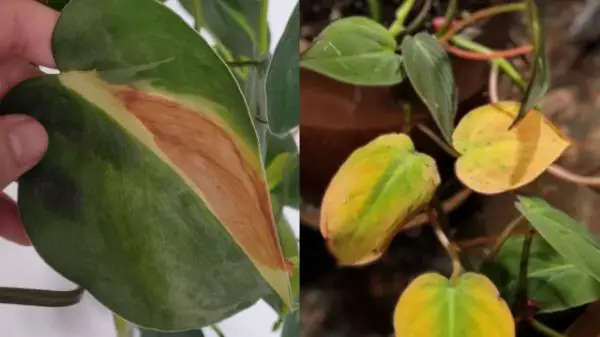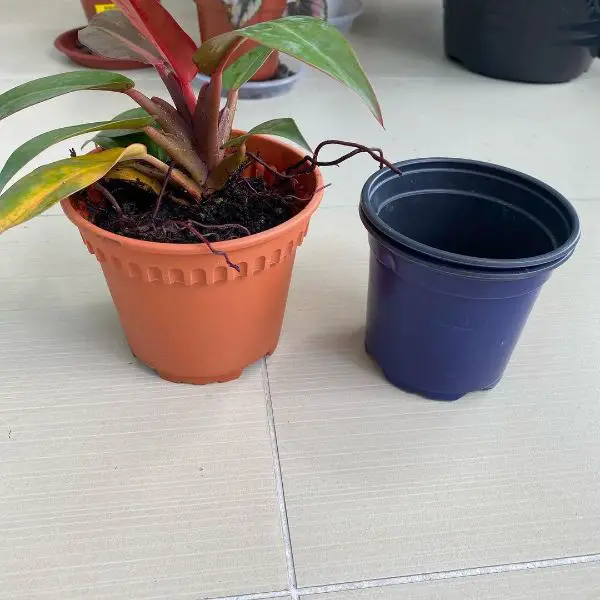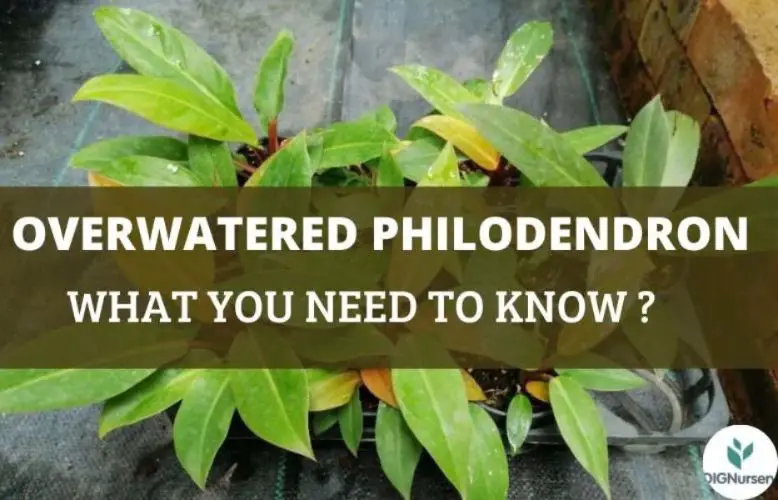If your Philodendron is starting to look a bit too lush and green, or a wilted, brown Philodendron, it might be overwatered. This common houseplant can be easy to care for, but if you’re not careful, you can overwater it and damage the plant. This is a real problem, and it’s important to know how to fix it.
In this blog post, we will discuss what overwatered Philodendron looks like, how to prevent it, and what to do if your plant has been overwatered.
How do you know if an overwatered Philodendron?
Firstly, you should tell the difference between an underwatered and an overwatered Philodendron. You can look at your Philodendron’s leaves to see how they are doing.
Overwatering is usually at blame if they resemble soggy, drooping leaves. And a plant that is underwatered is the reason why the leaves become dry, twisted, and crisp.
If you see any of the following signs, is an overwatered Philodendron:
Wilting and droopy the whole plant
After being exposed to water for an extended period of time, The roots of your Philodendron have ceased functioning properly. When you overwater your plant, this occurs.
The leaves will start to look sad and droop. The plant is unable to absorb enough nutrients and moisture. The majority of the plant’s leaves would already be turning brown and mushy, and the entire plant would be wilting.
Brown or yellow leaves
If the tops of your Philodendron leaves have noticeable dark stains, your plant may be overwatered.
The spots are initially smaller in size, as you will see. But with time, the spots get larger and gradually spread to adjacent leaves, damaging other plant sections.
The margins of the leaves will first turn brown, followed by the center. The leaves decay as a result of too much water remaining on them.
In addition to the brown patches, a Philodendron will also exhibit symptoms of yellowing leaves. When too much water a dysfunctional root system. The plant is lacking in nutrients, as evidenced by the yellow leaves.
The roots die when there is too much water present. The transport function is impacted. As a result, the leaves won’t receive enough nutrients and water from the soil.

Slow growth
Overwatering could be the reason why your plant isn’t developing as quickly or why the leaves are smaller than usual.
Overwatering makes also the plant leaves difficult for the plant to perform its typical photosynthetic process. The Philodendron cannot obtain enough nutrition, and its growth is inhibited.
Rotting roots
Overwatering can also cause root rot. Unless you take the plant out of its container, it will be difficult for you to determine this. The texture and color of rotting roots would be dark brown to black. It also has a bad smell.
There may be evidence of pathogen infection on certain roots. It occurs when the roots become damaged by spending too much time in the water, which causes them to absorb too much water and suffocate.
As a tropical plant, Philodendron will not thrive in wet soil. For an extended period of time, overwatering any plant causes the roots to stop working properly and weaken as a result of excessive water absorption.
Stem rot
Stem rot near the base of the Philodendron is another sign of overwatering.
This area is close to the roots yet is located above the soil line.
The stem will typically feel sticky, soft, and limp. Additionally, it will feel feeble.
Typically, the stem needs to be strong since it supports the plant above it.
If you try to repot the plant while the stem has stem rot, it’s likely that the stem may snap easily and split apart from the roots.
As root rot progresses upward, stem rot may develop. Or it might also be brought on by a fungal infection that arises from the moist.
Diseased Philodendron
Overwatering damages your plant, making it more vulnerable to illnesses.
In particular, an overwatered philodendron is more susceptible to contracting infectious illnesses. When the environment is persistently damp, pathogens develop and multiply.
Your plant will be more vulnerable to bacterial infections, fungus, and pests. They can be seen on the soil, leaves, and stems. Your philodendron plant will very certainly suffer damage from these germs, insects, and fungi.
The causes of overwatering
There are a few different causes of overwatered Philodendron. One of the most common causes is overwatering. This can happen if you water it more often than necessary or if you don’t let the soil dry out between waterings.
Another common cause of overwatering is using a pot that’s too small. This may result in the plant suffocating as a result of the roots becoming soggy. If you’re not careful, overwatering can kill your Philodendron.
You can read: Brown spots on Philodendron leaves & Effective Solutions
What you can do to prevent overwatered Philodendron
You can prevent root rot if you take precise actions as soon as you realize that your philodendron is being overwatered.
How resilient your plant is, the kind of damage brought on by overwatering, and your treatment of it can all have a significant role. The condition could become worse if the treatment results in any damage.
Let’s now look at how to fix your philodendron that is too wet.
If the overwatering is not severe, you can remedy the problem by following these procedures include 8 steps:
- Gently tilt the pot To get the standing water out
- Placing the pot in a location with sufficient airflow and indirect lighting will allow the soil and pot to completely dry out.
- Since the plant is already stressed from overwatering, make sure the light is not too strong or harsh. The stress can be increased by too much light.
- Clear the tray under the cooker.
- Don’t fertilize the plant till it has recovered. Fertilizer addition can make the plant even more stressed.
- The Philodendron should be situated a few feet away from any heating source to allow the extra water to evaporate. Be careful not to overdo it.
- Maintain lower humidity. Once the plant has recovered, you can use the humidifier once more.
- Make sure there is adequate airflow, but avoid exposing the plant to extremes of heat or cold.
If the overwatering is severe, the 8 steps listed above won’t be sufficient. You should:
Pruning overwatered Philodendron
- The foliage that is turning yellow, brown, and black has to be removed.
- Trimming off the damaged and dead leaves for the growth of new, younger leaves will be aided.
- Always wear gloves when trimming the leaves to protect your hands. Philodendrons have poisonous characteristics that could irritate the skin.
- To stop the spread of illnesses, always perform clean cuts with sterile equipment.
Additionally, some leaves can be pruned to lessen the plant’s stress.
Dry the soil
- Use sticks to make sure that the holes at the bottom of the pot are poked in order to drain any standing water. By doing this, the water will flow more easily and the draining will function more efficiently.
- Consider digging additional drainage holes if the drainage is still ineffective.
- Take the plant out of the pot, lay the soil and roots out on some paper, and allow the soil to dry if it isn’t already and is still holding water.
- To boost the airflow and hasten the drying of the water, use a fan.
- By utilizing a dehumidifier, reduce the humidity.
- In order to make the potting soil well-draining, check it and add perlite or pumice.
- Gently remove the roots of the old soil.
Cut off the damaged roots
- Get rid of the damaged roots as soon as you notice any indication of root rot.
- You can also remove the damaged stems from the plant, i.e., the stems that are really mushy and soft.
- Pruning the afflicted areas would be preferable if the root rot is severe on your Philodendron.
- Repot your Philodendron If the root rot is extreme
Repot the overwatered Philodendron
- Wait till the ground starts to dry out a bit. If the soil is too damp and squishy, repotting a plant will be challenging and messy. Use powerful lighting to hasten to dry.
- Remove the Philodendron from its current pot gently. By squeezing the pot on both sides, you can loosen the soil.
- Keep in mind that holds the plant gently.
- Remove old soil that surrounds the roots and the root ball by gently shaking it off. Use your hands to separate the roots and the root ball.
- Look for any signs of deterioration at the roots. Remove the rotting, old, and dead roots. To clearly observe the color of the roots, you can also wash them.
- Give the roots some time to air dry. You might also use a newspaper or tissue to gently pat it dry. Take caution not to damage the roots.

Prevent pathogens
- Use curative fungicides and preventive fungicides to prevent infection and against fungi. Only after the illness has already started does the curative fungicide take effect.
- Preventive fungicides used as preventative measures work to stop the fungus from invading the plant. The plant has to have it applied to it repeatedly.
- Place the Philodendron into a fresh pot with soil that has already been disinfected. Use only potting soil with appropriate drainage properties. For Philodendron, vermiculite, sphagnum peat moss, and perlite produce a fantastic soilless combination.
- The soil should be well-drained and thoroughly watered. Put the replanted Philodendron in a spot with some shade.
How to water a Philodendron properly so that it doesn’t become overwatered
Knowing the right methods to water your Philodendron can help you prevent overwatering. The following are crucial pointers for watering a Philodendron plant correctly:
- Place the pot on top of a tray that has water in it and water the plant from below the pot. Allow it to sit for a few hours so that the soil may absorb the water that has been drawn out. Never, however, keep the pot submerged in water for the whole night as this will promote root rot.
- Decrease the frequency of watering in the winter to prevent the soil from being excessively saturated. When the heat is particularly strong in the summer, do the reverse.
- Check the temperature and humidity. With low temperatures and high humidity, less watering will be necessary. On the other side, when the temperature is high and the humidity is low, more water is required.
- Before you water your plant, check the state of the surroundings. You are unable to maintain a single schedule.
- Rainfall or filter tap water before using it to water Philodendrons. You can let the water alone for at least 24 hours if you don’t have a filter system at home. These substances have ample time to evaporate from the water. Remember to avoid acid rain.
- Water the Philodendron in the early morning, preferably before 10:00. It is advised to follow this plan because it will allow the water to evaporation time during the day.
- Prevent watering in the afternoon or during periods of intense heat. Your plant’s size will determine how much water it needs.
- Check to see if the potting medium is moist and well-drained.
Your Philodendron can need additional watering every day in the summer. You must water your Philodendron right away if it begins to wilt.
When to give up on a wilted Philodendron and how to dispose of the plant properly?
When wilted Philodendron it can be pretty difficult to save the plant. So you can dispose of the plant properly as:
- Remove the damaged stems from the plant, the stems that are extremely mushy and soft.
- You can utilize a few stems or leaves for propagation if they are still in good condition. You must cut a 3–4 inch long vine or stem with a few leaves on it. Then place them in a soil-filled container or a jar with water
- To maintain the right humidity, water the cuttings and wrap them in plastic. Move the plant from a container filled with a new soil mixture once the roots begin to emerge. The plant can also be kept in a glass jar and let grow in water.
- Utilize new dirt. Avoid using old soil since it could get contaminated with bacteria and fungi.
- Fill the new pot with a fresh mixture of perlite and peat-based soil before planting your Philodendron.
- Neem oil can be used to protect the plant from various insects and fungi.
- Put your planter in a bright area where it will receive some indirect light. Avoid the sun’s rays; they will burn you.
- Additionally, wait until your plant has recovered from the harm before adding fertilizers.
Conclusions:
Overwatered Philodendron is one of the most common causes of plant death So it’s important to be aware of the signs and take steps to correct the problem. With a little care, your overwatered philodendron will soon be back to its usual healthy self.
It’s important to remember that even if you follow all steps, sometimes things will still go wrong. If your philodendron is looking wilted and droopy for more than a week or two despite your best efforts, it might be time to give up and dispose of the plant properly.


